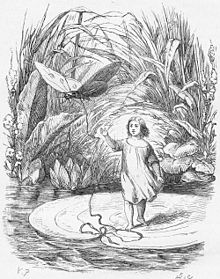Thumbelina
| "Thumbelina" | |
|---|---|

Illustration by Vilhelm Pedersen,
Andersen's first illustrator |
|
| Author | Hans Christian Andersen |
| Original title | "Tommelise" |
| Translator | Mary Howitt |
| Country | Denmark |
| Language | Danish |
| Genre(s) | Literary fairy tale |
| Published in | Fairy Tales Told for Children. First Collection. Second Booklet. 1835. (Eventyr, fortalte for Børn. Første Samling. Andet Hefte. 1835.) |
| Publication type | Fairy tale collection |
| Publisher | C. A. Reitzel |
| Media type | |
| Publication date | 16 December 1835 |
| Published in English | 1846 |
| Preceded by | "Little Ida's Flowers" |
| Followed by | "The Naughty Boy" |
"Thumbelina" /ˌθʌmbəˈliːnə/ (Danish: Tommelise) is a literary fairy tale written by Danish author Hans Christian Andersen first published by C. A. Reitzel on 16 December 1835 in Copenhagen, Denmark, with "The Naughty Boy" and "The Traveling Companion" in the second installment of Fairy Tales Told for Children. "Thumbelina" is about a tiny girl and her adventures with appearance- and marriage-minded toads, moles, and cockchafers. She successfully avoids their intentions before falling in love with a flower-fairy prince just her size.
"Thumbelina" is chiefly Andersen's invention, though he did take inspiration from tales of miniature people such as "Tom Thumb". "Thumbelina" was published as one of a series of seven fairy tales in 1835 which were not well received by the Danish critics who disliked their informal style and their lack of morals. One critic, however, applauded "Thumbelina". The earliest English translation of "Thumbelina" is dated 1846. The tale has been adapted to various media including television drama and animated film.
In the first English translation of 1847 by Mary Howitt, the tale opens with a beggar woman giving a peasant's wife a barleycorn in exchange for food. Once planted, a tiny girl, Thumbelina (Tommelise), emerges from its flower. One night, Thumbelina, asleep in her walnut-shell cradle, is carried off by a toad who wants her as a bride for her son. With the help of friendly fish and a butterfly, Thumbelina escapes the toad and her son, and drifts on a lily pad until captured by a stag beetle who later discards her when his friends reject her company.
...
Wikipedia
